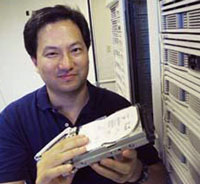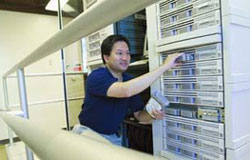Fast Wireless and Wired Grids Enable Experimental Computer Science
|
8.29.03 -- A visionary team led by Andrew Chien has received an NSF research infrastructure grant to build FWGrid, a prototype of technology that will be pervasive five years into the future. FWGrid includes high-speed wireless, wired, compute, and data infrastructures that will support next-generation systems and applications. Chien, the project’s PI, is a faculty member in UCSD’s Computer Science and Engineering Department (CSE) and a leader for system software research on the Calit² OptIPuter project. For FWGrid, he is working with a large team of CSE researchers, including David Kriegman, Joseph Pasquale, and Stefan Savage as co-PIs. The award is approximately $1.8M over five years.
According to Chien, anticipated large increases in speed across a range of technologies - computing, storage, and wired and wireless communications - are what's making it possible to fundamentally re-examine questions about applications structure. Computing power is expected to double every 18 months over the next 10 years. Storage is expected to double in capacity/cost every 12 months. While the rapid increase in wired bandwidth is widely publicized, the rapid improvement in wireless performance from 11 Mbps (802.11b) to 54 Mbps (802.11a/g) to ultimately 500 Mbps or more is less widely appreciated.
|
What's new is that this future world will be characterized by dramatically cheaper communication, which is also becoming, for the first time, cheaper than computation and storage. This means that the most important emerging capabilities for Grid elements will be their ability to communicate with each other and perform input/output. This, to the team, suggests a new hierarchy of capabilities. At the center, what Chien calls "the core," will be super-high-bandwidth networks, large compute servers, and data centers. At "the edge" will be wired high bandwidth, desktop compute platforms, and fixed cameras. And at the "mobile periphery" will be wireless high bandwidth, mobile devices with large compute and data capabilities, and arrays of small devices such as PDAs, cell phones, and sensornets. FWGrid leverages the new CSE building as a platform for experimental telecommunications and information technology infrastructure, deploying an intensive computing, wired, and wireless networking infrastructure to enable a wealth of research.
The FWGrid infrastructure to be deployed will be based on rich wired networks reaching 100 Gbps, high-bandwidth wireless of 500 Mbps, distributed clusters with large compute and data capabilities (teraflops and 10s of terabytes, respectively), and mobile image/video capture and display devices. In this living laboratory, the team will have access to real users and actual workloads to experiment with new applications, applications structures, system architectures, resource and system management, and algorithms.
The combination of high-speed wireless (mobility) with the computing and data manipulation power of the core will create opportunities for a mobile, interactive, augmented-reality environment. Such environments support an exciting range of applications with dramatically different functionalities, including the following:
- Visual personal diaries: Using multiple video cameras and microphones, users will be able to capture everything seen and heard in multi-perspective form. The data will be able to be streamed back to the core, annotated, and played back or accessed via wired or high-speed wireless devices.
- Omniscient digital observers: By instrumenting network, computer, and storage elements, the team will be able to monitor, log, and analyze all digital activity in the building.
- Visual lab monitors: The team expects to deploy fixed and mobile cameras and use advanced image, object, and action segmentation and recognition to create detailed activity logs for experimental labs. These logs can then be used for training, managing quality control, documenting activities, and supporting audits.
"Such applications," says Chien, "will enable mobile users to capture and display rich, 3-D information in a fashion that interleaves digital information with reality. These applications and the FWGrid infrastructure will provide a vehicle for developing innovative technologies and explore critical systems dynamics issues for what is increasingly called cyberinfrastructure."
The infrastructure will support four major research efforts:
- Computational and data grids: Development, evaluation, and application of Grid simulation tools to model coupled network, compute, and storage behavior.
- Vision and graphics: Image-based modeling and rendering for photorealistic augmented reality and collaboration and annotation of multi-video streams.
- Distributed computing: Investigation of models of network computing based on extended communication models.
- Network measurement and analysis: Mobile video collection and analysis, and automated network diagnosis and large-scale tracing.
Notes co-PI Kriegman, "FWGrid will enable experimentation in a wide range of large- scale computer vision applications by providing an unprecedented combination of computation, storage, and network bandwidth tightly coupled to a multitude of digital video sources. We're very excited about the opportunities this NSF award will afford us.
Related Links
NSF Awards $1.8 Million for Experimental Grid Infrastucture on UCSD Campus



